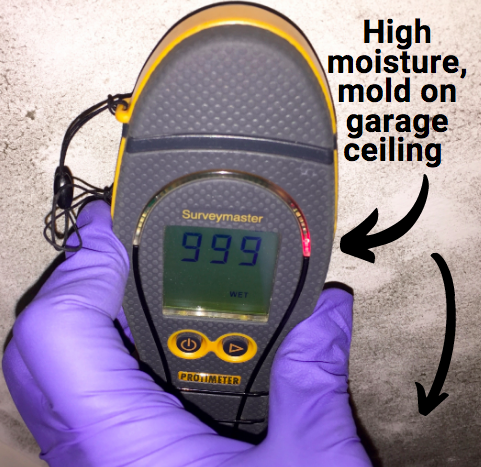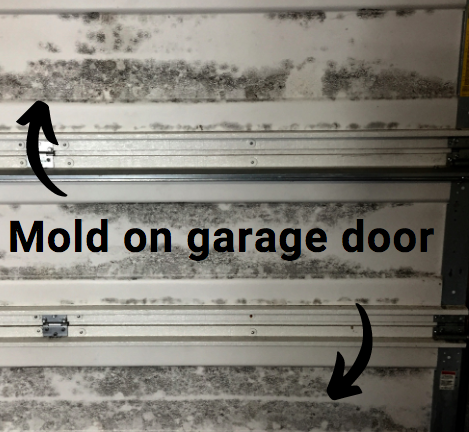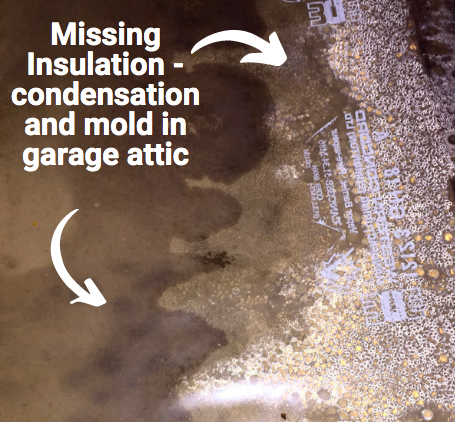Why Is Mold Growing In My Garage?
Have you been plagued by unsightly garage mold on the walls, ceilings, window sills and storage items?
If so, you are in good company...
This chapter goes into detail about the different sources of mold in the garage, signs to look for, how to deal with mold once you see it and last, how to prevent mold in your garage from coming back.
Garage mold is not talked about a whole lot, but it is actually quite common.
Detached garages tend to have more mold related issues compared to attached garages because they are unsealed, more exposed to the elements and cooler overall.
When compared to the home, there is usually more moisture in the garage. Humidity from the pooling water brought in by vehicles, foot traffic, and rain is common.
During the winter, significantly more water will enter the garage, which leaves little doubt as to why mold issues often crop up.
One of the reasons for this has to do with the fact that moisture will stay around longer when the temperature is cool.
Most people don't bother heating the garage, so moisture lingers around, which leads to a perfect environment for mold growth.
Once mold spores establish a place to settle and grow, they will release more and more spores, and quickly start to spread onto other surfaces in the garage. Within a number months, mold can take over 70-80% of a surface area! Quick action is then needed!
Besides the humidity, garages attract dirt and organic debris - a perfect source of food for mold. Much of our storage items make their way into the garage, only to be forgotten until months or years later.
Any moisture that accumulates on or inside these items can easily be infected by mold. Specifically, I'm talking about cardboard, wood, drywall, fabrics, and paper items.
When these items are stacked right up against the garage walls, or corners without any airflow, mold can grow undetected.

What Causes Mold On The Garage Ceiling?
Water damage caused by roof leaks, or issues in the attic above the garage can contribute to garage mold. The evidence can be seen on the ceiling, showing up as dark stains.
Consider the following scenario…
I was looking at a serious mold problem in a detached garage. The mold was covering approximately 75% of the ceiling space.
The owner of the home discovered a small amount of mold the year before but didn’t think much of it until it started to take over.
Of course, this puzzled the owner, so he called me in to investigate. As part of the inspection, I took a number of moisture readings along the surface of the ceiling.
The surface area was damp, ranging from 60-99% across the entire ceiling.
When I took a look in the attic above the garage, everything made sense to me. What I discovered was the attic floor was missing insulation.

Insulate The Attic Above The Ceiling
Insulation needs to be installed to keep the temperature consistent and warmer along the surface of the attic floor and ceiling of the garage.
Without insulation, condensation will develop on the surface of the garage ceiling.
When the dust settles, mold spores will land on the dust, consume it and begin to thrive, especially when the surface stays wet for more than 24-48 hours.
This picture shows what can happen when mold takes over a large area of a ceiling in the garage.

When your garage is cool and wet, with limited ventilation and dirty, you can expect mold spores to spread along with the ceiling, corners, windowsills walls, or on the garage door, as seen in the photo.
Over time, the surface of the cooled door will accumulate debris, which is essentially mold food.
Fortunately, this is easily dealt with and can be prevented long-term by using a mold removal product from your local hardware store.

Dealing With Mold Growth In The Garage
If you notice a relatively small area of mold, don’t ignore it because mold removal is expensive and in most cases easily avoidable. Instead, call in a mold inspector to find the source of the problem. Your mold inspector should do the following:
If needed, your mold inspector will send you a written report to go along with the mold inspection. If the mold problem is serious, then you will likely need to call in a mold remediation contractor.
Once you hire a mold remediation company to remove the mold, you want to make sure it doesn't come back, so ask for a written guarantee.
How to Control & Prevent Garage Mold
When you control the environment inside the garage, you will prevent the mold from starting or coming back.
Garages can get cold, especially during the winter, so installing a heater is a great idea if it is not there already. This helps any existing moisture evaporate quickly.
You need to keep the area dry and control the build-up of debris on the walls, ceiling, window sills, and doors. Essentially all surface areas, including storage items.
Take a good look at all interior areas, including the floor, corners, walls, and ceiling. If your garage has an attic space, take a peek up there, noting any signs of leakage, moisture, or water damage.
You should remove all standing water and dry the floor if possible. A squeegee is excellent for pushing the water outside.
Check the humidity level, especially during the winter. If it is above 55% then use a dehumidifier, set to 40% or less. You can get one at your local hardware store or online.
If the humidity is too high, consider installing a fan to vent the humid air outside. A ventilation contractor can help you with this.
All documents and photos should be removed from the garage, particularly if they are in cardboard boxes. Place all items inside the home, within sealed plastic bins instead.
If you don’t want to spend the money on a fan, consider moisture-absorbing products from the company DampRid.
It is a good idea to keep things on shelves rather than on the floor to prevent trapping any moisture below the storage. The shelf itself should be placed a few inches away from the wall to allow for adequate airflow.
The garage should be properly ventilated to encourage air exchange. Stale humid air will encourage mold growth.
Roof leaks can be avoided by checking inside the attic of the garage and course, the actual roof over the garage. This photo shows what can happen after an undetected roof leak.

Removing all cobwebs, dust, dirt, leaves, and bugs every few months will significantly reduce the mold’s food source, so this is worthwhile. Go through your storage items every few months. Remove all garbage or excess paper-based items.
If you plan on upgrading or remodeling the garage, be sure to use mold/mildew-resistant paint and materials and insulation, rather than just drywall over concrete.
To prevent moisture and mold from growing inside the attic or along the garage ceiling surface, the temperature needs to be consistent.
You can achieve this by insulating the floor of the attic to a level of R50 (Resistance Value).

I hope these tips have given you a better understanding of why mold grows inside your garage, what to do about it, how to remove it and prevent it from coming back.
In the next chapter we will explore why kitchen mold is a common menace and what to do about it, so check it out...
